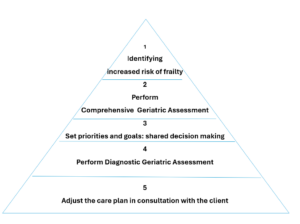Frailty
Symptoms that may indicate an increased risk of frailty include:
- increasing forgetfulness
- ADL dependence
- polypharmacy
- multimorbidity
- aged 65+
- low SES
- avoidance of care or not knowing how to get professional help
- unsafe living situation
Recognizing these criteria is part of Step 1: identifiying older people at increased risk of frailty. (See figure 1: Buurmans Pyramid). You can also use the Tilburg Frailty Index (TFI) or the Groningen Frailty Index (GFI) for this. If an increased risk of frailty has been identified (generally four criteria or more), it makes sense to perform a Comprehensive Geriatric Assessment (CGA) with these clients.

Buurman’s Pyramid
Definitions of frailty differ. In addition to physical frailty (limitation in ADL, mobility, etc.), the broad definition also includes psychological frailty(e.g. depression, dementia, personality problems) and social frailty (e.g. low socio-economic status, living situation, access to care). Older people mainly define frailty as “threat to quality of life”.
Bron:
Van Campen C. (2011) Kwetsbare ouderen Den Haag: Sociaal Cultureel Planbureau
Buurman B. in: Bakker T., Habes V., Quist, G., Van der Sande, J., Van de Vrie, W. (2019) Klinisch redeneren bij ouderen. Functiebehoud in levensloopperspectief. Bohn Stafleu van Loghum


